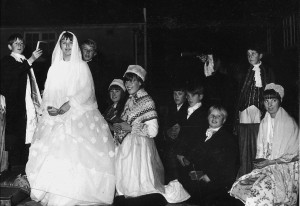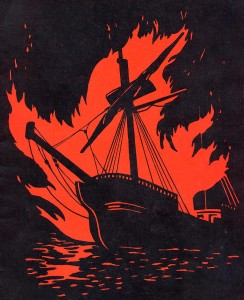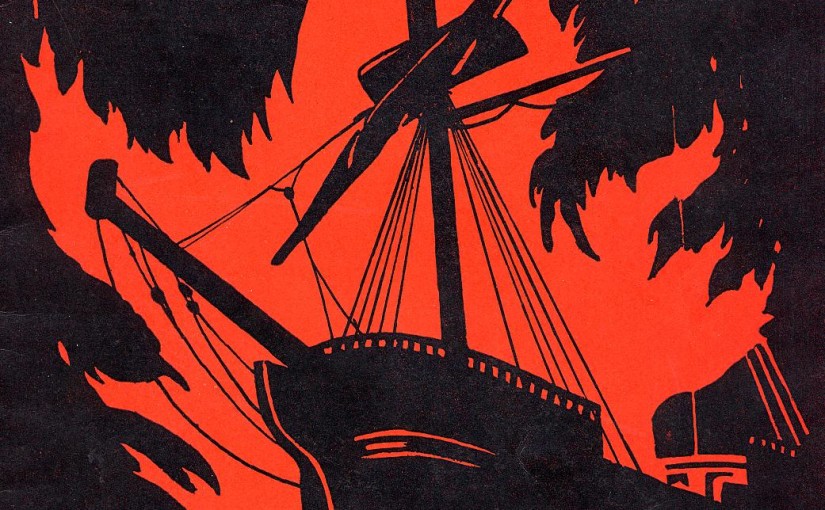Recapture Moments from the Past, Worthy of Preservation.
Sixty years ago in 1945 the Second World War had just reached it’s terrible conclusion with the discovery of the death camps in Europe and the dropping of two atom bombs on Japan.
The British military survivors of the six year conflict had returned home to their families and were picking up the pieces. By November they were looking to have fun again and the Rye Fawkes Pageant was revived in that same year.
The Mayor of Rye, Alderman J. Cooper, announced that “The people of Rye and their neighbours have experienced many grim incidents of the War during my term of office. A ‘Guy Fawkes Pageant’ should help to recapture some of those joyous moments of the past that are so worthy of preservation.”
In the offices at “Rye’s Own” is a battered file which bears the title ‘Bonfire Nights 1945-53. Contained therein is a treasured 1946 programme which says so much about Rye at that time. It records the names of the men and women who were the heart and sole of the town. Ernie Odell the Cycle Man, Alfred Horner who was to become one of the greatest Mayor’s this town has ever seen, Arthur Paine, Jim Pilcher, George Pope, W. Clark, Mrs. M. H. Mackechnie, E. H. Stutely, J. H. Langton, Reginald Prebble, John Winter, Clifford
Bloomfield, Bobby Edwards, Frank Taylor, Walter Dawes, Miss J. Downey, C. Standen, Vic Clark, Miss J. Larkin, Mrs. J. Lee, L. Adair, Mrs. Ashbee, Mrs. W. Bodilly, Ernie Goddard, Frank Small, Mrs. Stonham, P. Jempson, Miss Lister, Les Page, Frank Borne and Sonny Martin to name just a few.
New Ryers may not recognise many of these names but those who have been around a while will recall most of them with great fondness.
The Bonfire celebrations were a much less inhibited event than those we know today. There were few regulations, no insurance and the whole thing was run on a lot of common sense, good luck and trust in the ability of the Rye Fire Brigade to cope with any problems.

In 1945 one of the tableaux, “Mutiny on the Bounty” suffered bad luck. Coloured flares set light the sails and the blaze necessitated the attention of the National Fire Service (as it was still known) who were handicapped by the fire igniting a large number of fireworks in the boat. (‘Twas a grand show!)
In 1947 the Firework display was staged by Joseph Wells & Son ‘Sole Pyrotechnists to Henley Royal Regatta’, the programme proudly announced.
Efforts were made to entice Sir Winston Churchill to become Rye Fawkes in 1953. Sadly he declined the offer. He had possibly heard of the terrifying trip that each occupier of that sedan has to endure going to and coming back from the giant pyre. Indeed, when the famous musical comedy actress Evelyn Laye was announced in the programme it did also state she would present the prizes at Bryan’s Garage IF she survived the trip.
By 1953 the ‘Dragon of Rye’ with a ten foot long tongue of flame shooting from it’s mouth with a terrifying roar, had been introduced to the procession. It was such a brilliant creation it was taken from town to town winning prize after prize. These days he would not be welcome by ‘Health and Safety’ and would be banned from the streets. Today we have his much gentler grandson, the Jolly Green Dragon
Of the fifty or so advertisers in the 1953 programme only four businesses still exist. Adams, Frank Goulden’s, Dennis the Ironmongers and Rose Anne. Alas so many old Rye firms are no more.
This year’s event will be its usual colourful success but those that remember the crisp November nights of yesteryear will recall those great figures and characters who lit up the night on the fifth in days gone by.
====================================

Bonfire Anecdotes
From the days when Rye Burned its Boats.
A wealthy resident in the High Street declined to subscribe to Bonfire Funds. On the great night a blazing boat was hauled through the town and broke adrift immediately outside his newly painted house. Unfortunately, the heat was so great that a chain could not be affixed and the boat was left to burn out. It is understood that he became a regular subscriber in after years.
A strenuous police effort to prevent the usual passage of a burning boat resulted in a cry for water. A bucket was hastily produced and the contents (paraffin) thrown on the flames.
In former days, six special constables were sworn in for “the fifth.” Four played cards and two kept a look-out for the regular police.
In 1945 it was impossible to arrange a professional Firework Display and local traders reserved their entire stocks for the “Bonfire Boys”
November 3rd. 1946. The fireworks for Rye had been lost in transit – In reply to frantic phone calls, a duplicate set was sent by road in time for the 5th.
The famous Burning Boat emblem that appears on the programme each year was designed by Mrs. Mackehnie in 1946.
British soldiers used captured German fireworks for a “Victory” display at the end of the War. A rocket containing thousands of Swastikas was NOT used.
Guy Fawkes came from a respectable Yorkshire family, his father was a Notary at York and Registrar and Advocate of the Consistory Court of the Cathedral. The date of his birth is unknown – his death 1606.
BIN LARDIN FAILS TO STOP RYE FAWKES
The 2001 Rye Fawkes celebrations go ahead on November 10th. despite Bin Lardin and his henchmen who had made their despotic attack on the World Trade Centre in September of that year. The President of America, George Bush, has asked Americans to go about their business as usual, this must apply to the British as well. No doubt there was some apprehension from the authorities about such a large gathering but they were brushed aside. If we had let terrorists rule our lives the forces of evil would have been half way to victory. The Bonfire Boys are made of tough stuff, they had overcome all kinds of objections in the past to keep the event going over the years.
Rye’s Bonfire celebrations could be older than Guy Fawkes himself. Some say that celebrations with bonfires in Rye were first held to commemorate the young men of the town’s retaliatory raid against the French in 1378 when they returned to wreak revenge, burning and pillaging and snatching back the Church Bells which had been stolen in ’77. Descriptions of the 1840 to 1889 Rye Fawkes Celebrations when burning boats were dragged around the town, seems a re-enactment of the 1378 raid when Ships laden with burning barrels of tar were dragged around the streets. The events in Rye between 1840 and 1889 were, by some accounts, “A time of terror for many inhabitants”. There were running battles with the local police force and many extra constables had to be brought in from outside the area to keep any semblance of control. There has by tradition been verbal conflict between Bonfire Societies and the Sussex Police. Even to the point of effigies of local Police Chiefs being blown to pieces as the fire was ignited. Up to 1894 boats were stolen from their moorings and dragged burning around the town and barrels of burning tar were rolled down Conduit Hill. Fortunately today’s celebrations have lost the “terror” element. There is only one burning boat now, and even that is very tame affair compared to those in fairly recent times. As late as 1970 the burning boat was always followed in the procession by the Fire Engine, just in case!
